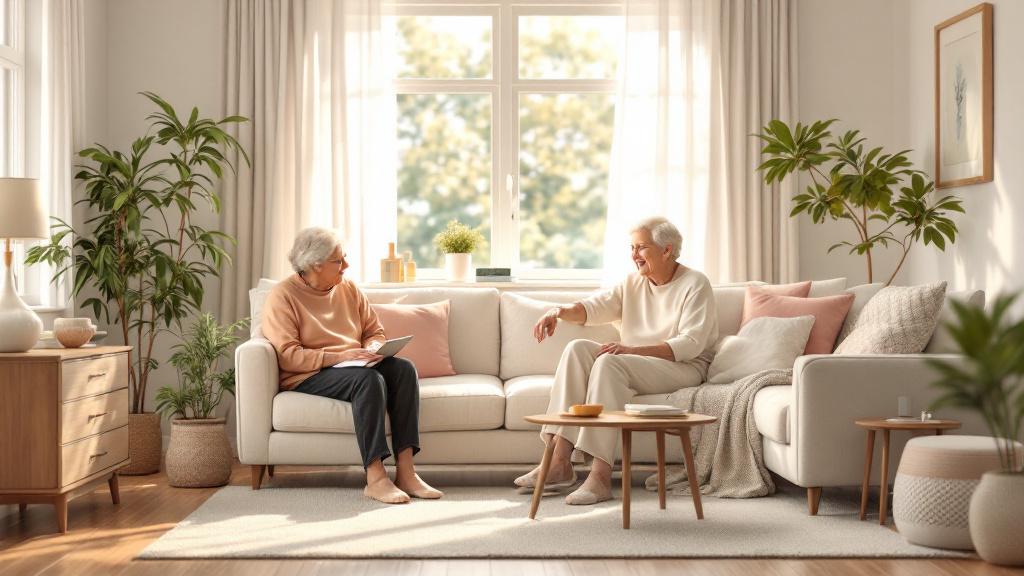How to Create a Safe and Comfortable Space for Caregiving Activities
Creating Safe Havens for Caregiving: A Practical Guide

Introduction
Caregiving within the home environment presents numerous challenges and opportunities, especially when it involves elderly individuals or those with specific health conditions. To ensure that both safety and comfort are met, it is essential to adapt these spaces thoughtfully. By addressing key aspects of the environment, caregivers can create spaces that not only make caregiving more manageable but also improve the quality of life for those they care for.
Understanding the Three C's of Caregiving

What are the three C's of caregiving?
The three C's of caregiving are Comfort, Compassion, and Companionship. These concepts form the foundation of an effective caregiving environment, particularly for elderly clients or individuals with special needs.
Why are the three C's important in caregiving environments?
Comfort is crucial; it involves personalizing living spaces with familiar items and ensuring supportive furnishings. A comfortable environment helps reduce anxiety and fosters a sense of security, which is especially important for individuals facing physical and emotional challenges.
Compassion entails understanding the unique needs of each client, allowing caregivers to approach their roles with empathy. This understanding builds trust and encourages open communication, which enhances the caregiving experience.
Companionship plays a vital role in maintaining seniors' mental health. Social connections can combat feelings of isolation, allowing caregivers to engage with clients through conversation and shared activities.
Incorporating the three C's creates a nurturing atmosphere that not only ensures the physical safety of clients but also significantly boosts their emotional well-being.
Safety First: Tips for Creating Secure Caregiving Spaces

Identify Danger Zones
Creating a safe environment involves identifying danger zones within the home. High-risk areas include bathrooms and kitchens where falls and accidents are more likely to occur. In bathrooms, caregivers can enhance safety by installing grab bars, using nonskid mats, and ensuring toilet seats are at an accessible height.
In kitchens, modifications such as lowering counter heights and utilizing single-lever faucets can make tasks easier and safer for both caregivers and care recipients. Keeping frequently used items within reach helps reduce the risk of accidents.
Fall Prevention
Fall prevention should be prioritized in caregiving spaces. Clear pathways and thorough decluttering can significantly reduce trip hazards. Caregivers should remove loose rugs and ensure that flooring is secure. Adequate lighting is critical; adding nightlights or replacing burnt-out bulbs can improve visibility in hallways and staircases.
Proper Lifting Techniques for Caregivers
Caregivers face physical demands when assisting their clients. Employing proper lifting techniques is essential to prevent injuries. Caregivers should bend their knees and lift with their legs rather than their backs. Using assistive devices—such as patient lifts—can also alleviate physical strain. Furthermore, caregivers are encouraged to take frequent breaks and maintain their physical health through exercise and proper nutrition.
| Aspect | Importance | Recommendations |
|---|---|---|
| Danger Zones | Identify and modify high-risk areas | Install grab bars and use nonskid mats |
| Fall Prevention | Minimize the risk of falls through clear pathways | Regularly check lighting and remove hazards |
| Lifting Techniques | Protect caregivers from injury | Utilize legs for lifting, employ assistive devices |
| Regular Assessments | Tailor the environment to meet client needs | Conduct frequent home safety evaluations |
Modifying Kitchens and Bathrooms for Ease and Accessibility

What are some strategies for modifying home areas like kitchens and bathrooms for caregiving?
To create safer and more accessible kitchens and bathrooms for individuals under care, simple yet effective modifications can make a significant difference. One vital strategy involves optimizing kitchen layouts to enhance safety and independence. Here are some recommendations:
- Place frequently used items within reach: Keep cooking essentials, utensils, and food items easily accessible to minimize bending and reaching over obstacles.
- Install single-lever faucets: These can simplify operations for caregivers and patients, making it easier to adjust water temperature with one hand.
- Use pull-out shelves in cabinets to reduce the need to bend down and make retrieval easier.
- Lower counter heights: Whenever possible, lower kitchen counters to provide comfortable working heights for seniors using wheelchairs or walkers.
In bathrooms, safety is paramount as they are often high-risk areas:
- Grab bars are essential: Install sturdy grab bars next to the toilet and in the shower to provide support and prevent falls.
- Non-slip mats should be placed in and around the shower or bathtub to reduce slipping hazards on wet surfaces.
- Raised toilet seats can also facilitate easier transitions for elderly individuals, promoting better mobility.
- Ensure proper lighting: Good illumination can help prevent accidents, especially during nighttime trips.
Implementing these modifications not only enhances safety but also supports the well-being of caregivers, making daily routines more manageable and less stressful.
Organizing Living Spaces for Comfort and Safety
Decluttering Tactics
To create a safe living environment, it’s essential to declutter regularly. Start by removing loose rugs and unnecessary furniture that may become tripping hazards. Make sure pathways are clear, and consider using storage solutions like baskets and bins to keep frequently used items organized and accessible. Engage clients in the decluttering process by asking for their input on what to keep, enhancing their sense of control and involvement.
Personalizing Spaces
Personal touches make a space feel inviting and familiar. Incorporating framed family photos, artwork, or cherished mementos can enhance comfort and foster a sense of belonging for clients. Encourage caregivers to allocate areas for activities and hobbies that reflect the individual’s interests, creating spaces that promote engagement and joy.
Lighting Improvements
Adequate lighting is crucial for safety and emotional well-being. Ensure all rooms are well-lit to reduce the risk of falls and enhance visibility. Use bright bulbs in essential areas and consider installing motion-activated lights for hallways and bathrooms. Soft lighting in relaxation areas can provide a calming atmosphere, contributing to a nurturing environment for both caregivers and the individuals being cared for.
Emotional Well-Being and Social Engagement

How can caregivers enhance emotional well-being and social engagement for those receiving care?
Caregivers play a crucial role in enhancing the emotional well-being of those they care for. One effective strategy is fostering strong social connections. This can be achieved through regular communication and shared activities, like volunteering or attending group classes together. Engaging in such interactions not only combats feelings of isolation but also promotes a sense of belonging and happiness.
Another essential aspect involves recognizing and addressing the unique cultural and individual needs of care recipients. Tailoring support strategies to these needs ensures that each individual receives meaningful care. For instance, caregivers can organize family meetings or interdisciplinary approaches to identify social needs early. This enables tailored planning and timely interventions.
Furthermore, involving care recipients in community events and recreational activities can significantly uplift their spirits. These experiences foster connection and joy, contributing to overall mental health.
Lastly, caregivers should prioritize providing access to mental health resources and evidence-based health promotion programs. Engaging both caregivers and care recipients in well-being initiatives builds resilience in their relationships and strengthens their emotional health. Ultimately, the emotional well-being of caregivers directly benefits those they care for, creating a nurturing environment for all involved.
Designing Rest and Respite Zones for Caregivers

Creating Private Spaces
Establishing dedicated areas in the home where caregivers can unwind is crucial for their mental health. A serenity-filled nook can be as simple as a cozy chair in a quiet corner or a more structured space with comfortable furnishings, calming decor, and personal touches like photos. This private zone should be clutter-free and equipped with soothing elements such as soft lighting, relaxing music, or even plants to enhance emotional well-being.
Importance of Self-Care and Breaks
Caregivers often face immense pressure that can lead to burnout. Regular breaks and time spent in a respite zone allow caregivers to recharge and return to their responsibilities with renewed energy. Acknowledging the need for self-care not only promotes the caregiver's well-being but also enriches the care they provide, creating a supportive environment for both caregivers and those they assist.
Integrating Technology and Safety Features in the Home
How Can Smart Home Devices Enhance Safety?
Smart home devices play a pivotal role in creating a safer environment for seniors and caregivers. From motion-activated lighting that illuminates dark pathways to automated temperature controls, these technologies help mitigate risks around the home. For instance, smart sensors can detect movement and adjust lighting accordingly, reducing fall hazards in dimly lit areas.
Moreover, voice-activated home assistants allow seniors to control their environment easily, such as adjusting the thermostat, turning on or off appliances, and even calling for help without needing to move. This can be especially beneficial for those with mobility challenges.
What Steps Can Be Taken for Emergency Preparedness?
Emergency preparedness is essential for ensuring the safety of individuals in caregiving environments. Maintaining a visible list of emergency contacts and ensuring first aid supplies are readily available promotes a quick response during emergencies.
Additionally, integrating alarm systems with door and window sensors can alert caregivers to potential hazards. Having an established emergency plan ensures that both caregivers and clients remain calm and aware of necessary actions during unforeseen events.
Incorporating both smart technology and emergency preparedness measures can significantly enhance safety, independence, and peace of mind for seniors and caregivers alike.
Conclusion
Creating a safe and comfortable space for caregiving involves both physical modifications and a mindful approach to emotional and social needs. By incorporating the strategies and tips outlined in this guide, caregivers can enhance the well-being of those in their care while also supporting their own health and resilience. Empowering caregivers and care recipients alike is key to fostering a productive, nurturing caregiving environment.
References
- A Caregiver's Guide to Creating a Safe Environment
- Creating a Safe and Comfortable Environment for Your Clients
- Caregiver tips: how to make homes safer and more comfortable for ...
- How Caregivers Can Create a Safe Environment for Their Patients
- Creating a Safe Haven: A New Caregiver's Essential Guide
- How to Create a Safe and Comfortable Environment for Seniors
- Creating A Comfortable Home Environment For In-Home Care - Tips ...

How to Plan for Long-Term Home Care Services

How Home Team Helps Families Make Informed Care Decisions

How Home Team's Caregivers Provide Peace of Mind for Families



